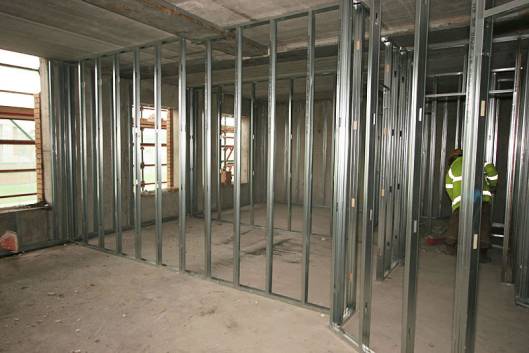How to Make a Metal Stud Wall

Traditionally a common method of creating internal walls is by making timber stud walls. However, a quicker easier way to do this is to make a metal stud wall, often referred to as stud and track. At its most basic the metal stud wall consists of metal tracks (sometimes also called channels depending on the manufacturer) fixed to the floor and ceiling with a series of regularly spaced metal studs connecting them. Plasterboard can then be fixed either side of the studs creating a wall ready for finishing.
Depending on the requirements of the metal stud wall a wide variety of different components are available to cope with any of the following:
- The height and width of the metal stud wall
- Insulation both acoustic and thermal
- Fireproofing
- Loads on the metal stud wall
- Openings in the wall such as doors and windows
- Services such as wiring or pipework within the wall
 A quick guide to the construction of a metal stud wall is below. More detailed instructions can be found on the websites of drywall manufacturers such as Siniat.
A quick guide to the construction of a metal stud wall is below. More detailed instructions can be found on the websites of drywall manufacturers such as Siniat.
- Having determined the position of the new metal stud wall appropriate metal tracks are suitably fixed to the floor and ceiling remembering to make sure that they are plumb with a laser level or plumb line.
- 'C' Studs are fixed to the abutments at either end of the new metal stud wall, again making sure that both are plumb.
- The position of the first stud should be marked at the required spacing from the end. Any door or window openings can also be marked at this time.
- An appropriate stud can then be fitted into the metal tracks at the marked position, and having checked that it is plumb, it should be fixed to the tracks using 13mm wafer head screws.
- This process can then be repeated for the remaining studs until the metal stud wall is complete.
- Door or window openings should be constructed as appropriate, again exact instructions can be viewed on manufacturer websites.
- The metal stud wall perimeter should be sealed on both sides with an appropriate sealant.
- Services can be located within the wall cavity. To prevent abrasion on any sharp edges wiring should be protected with a conduit or other suitable precaution.
- Insulation can be added to the wall cavity for increased acoustic or thermal performance.
- Plasterboards are fixed to the metal framework with specialist drywall screws.
Further information on where to obtain the components of a metal stud wall can be found on the ABC Depot website.












Comments